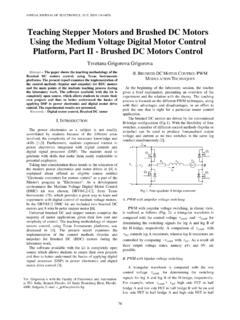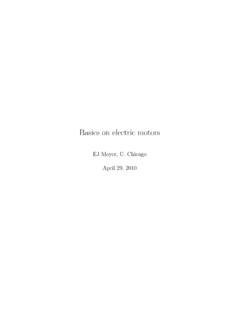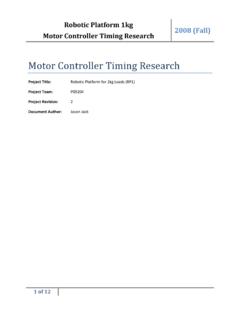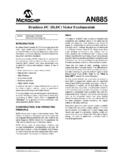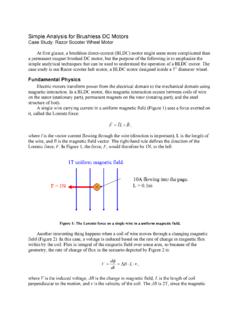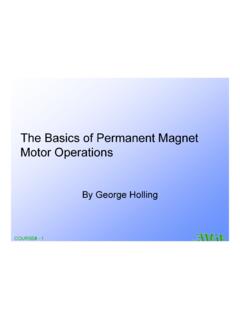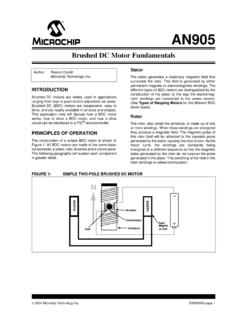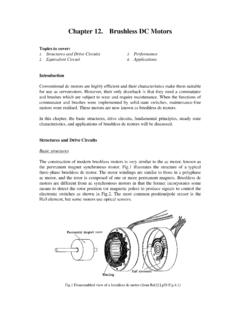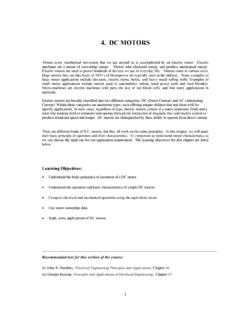Transcription of Stepper Motor System Basics - stepcontrol.com
1 _____ Phone: (512) 212-7300 1 Stepper Motor System Basics Table of Contents 1. Stepper Motor System OVERVIEW .. 2 2. STEPPING MOTORS .. 3 TYPES OF Stepper MOTORS .. 3 Motor WINDINGS .. 4 ADDITIONAL Motor CONSIDERATIONS .. 4 3. DRIVERS .. 5 DRIVER TECHNOLOGY OVERVIEW .. 5 TYPES OF STEP Motor DRIVERS .. 5 DRIVER AND Motor WIRING CONFIGURATIONS .. 5 PHASE CURRENT .. 6 4. CONTROLLER (INDEXER) .. 7 CONTROLLER OVERVIEW .. 7 STEP MODES .. 7 STAND-ALONE OPERATION .. 8 INTEGRATED CONTROL .. 8 MULTI-AXIS CONTROL .. 8 5. POWER SUPPLY .. 9 VOLTAGE .. 9 TYPE .. 9 AMPERAGE (POWER) .. 9 _____ Phone: (512) 212-7300 2 1. Stepper Motor System OVERVIEW Motion Control is the process of accurately controlling the movement of an object, based on speed, distance, load, inertia or a combination of all these factors.
2 There are numerous types of motion control systems, including: Stepper Motors, DC brushed and Brushless Motors, Servo Motors, and more. This document will concentrate on Step Motor technology. Stepper motors are a marvel of simplicity; they have no brushes or contacts for commutation, like DC motors. Instead, it's a synchronous Motor with electronically-switched magnetic fields which rotate the armature magnets. A Stepping Motor System consists of three basic elements, often combined with some type of user interface (such as a host computer or PLC [Programmable Logic Controller]): The User Interface provides a series of high-level motion commands. These guide the controller (or indexer) to generate the motion signals implied by those commands which the driver amplifies to drive the step Motor . The Indexer (or controller) is a subsystem which interprets high-level motion commands and generating motion primitives (step pulses and direction signals) for the driver.
3 In addition, the controller typically performs other sophisticated command functions based on commands, current status, or real-time inputs. The Driver (or Amplifier) converts the controller command signals into current levels necessary to energize the Motor windings. There are numerous types of drivers, with various current/amperage ratings and technology. Not all drivers are suitable to run all motors, so when designing a Motion Control System the driver selection process is critical. The Step Motor is an electromechanical device that converts drive waveforms into mechanical shaft rotation. Advantages of step motors are low cost, high reliability, high torque at low speeds, simple rugged construction, and operation in almost any environment. The main disadvantages in using a step Motor is the resonance effect often exhibited at low speeds, and decreasing torque with increasing speed.
4 Example Step Motors: AME Series _____ Phone: (512) 212-7300 3 2. STEPPING MOTORS TYPES OF Stepper MOTORS There are basically three types of stepping motors; variable reluctance, permanent magnet and hybrid. They differ in terms of construction based on the use of permanent magnets and/or iron rotors with laminated steel stators. The variable reluctance Motor does not use a permanent magnet. As a result, the Motor rotor can move without constraint or "detent" torque. This type of construction is good in non industrial applications that do not require a high degree of Motor torque, such as the positioning of a micro slide. The variable reluctance Motor in the right illustration has three "stator pole sets" (A, B, C,), set 15 degrees apart. Current applied to pole A through the Motor winding causes a magnetic attraction that aligns the rotor (tooth) to pole A.
5 Energizing stator pole B causes the rotor to rotate 15 degrees in alignment with pole B. This process will continue with pole C and back to A in a clockwise direction. Reversing the procedure (C to A) would result in a counterclockwise rotation. The permanent magnet Motor , also referred to as a "canstack" Motor , has, as the name implies, a permanent magnet rotor. It is a relatively low speed, low torque device with large step angles of either 45 or 90 degrees. It's simple construction and low cost make it an ideal choice for non industrial applications. Unlike the other stepping motors, the PM Motor rotor has no teeth and is designed to be magnetized at a right angle to its axis. The above illustration shows a simple, 90 degree PM Motor with four phases (A-D). Applying current to each phase in sequence will cause the rotor to rotate by adjusting to the changing magnetic fields.
6 Although it operates at fairly low speed the PM Motor has a relatively high torque characteristic. Hybrid motors combine the best characteristics of the variable reluctance and permanent magnet motors. They are constructed with multi-toothed stator poles and a permanent magnet rotor. Standard hybrid motors have 200 rotor teeth and rotate at step angles. Other hybrid motors are available in and step angle configurations. Because they exhibit high static and dynamic torque and run at very high step rates, hybrid motors are used in a wide variety of industrial applications where exact positioning and speed are critical. _____ Phone: (512) 212-7300 4 Motor WINDINGS Unifilar-wound motors have only one winding per stator pole. Stepper motors with a unifilar winding will have 4 lead wires.
7 The following wiring diagram illustrates a typical unifilar Motor . Bifilar-wound motors have two identical sets of windings on each stator pole. This type of winding configuration simplifies operation in that switching current (commutating) from one coil to the one wound in the opposite direction, will reverse the rotation of the Motor shaft. Whereas, in a unifilar application, to change direction requires reversing current within the same winding. The most common wiring configuration for bifilar-wound stepping motors is 8 leads because they offer the flexibility of either a series or parallel connection. There are however, many 6-lead stepping motors available for series-connection applications. The most commonly available Stepper Motor is the unifilar hybrid with full steps. There is more information on Motor winding types (4, 6 or 8-lead motors) and their tradeoffs in the driver section.
8 ADDITIONAL Motor CONSIDERATIONS The electrical compatibility between the Motor and the driver are critical factors in a Stepper Motor System design. Some general guidelines are: INDUCTANCE Stepper motors are rated with a varying degree of inductance. A high inductance Motor will provide a greater amount of torque at low speeds and lower torque at higher speeds. Motor STIFFNESS By design, stepping motors tend to run stiff meaning the default pattern of torque during motion appears stiff and jumps from one step to another (depending upon motion rate, current, etc). Reducing the current flow to the Motor by a small amount can smooth the rotation and increasing the Motor current could increase the stiffness but will also provide more torque. Trade-offs between speed, torque, step mode and resolution are a main consideration in designing a step Motor System .
9 Motor HEAT Step motors are designed to run hot (50 -90 C max). However, too much current may cause excessive heating and damage to the Motor insulation and windings. AMS motion control products reduce the risk of overheating by providing a programmable Run/Hold current feature, which reduces drive current during periods where motion is not needed. _____ Phone: (512) 212-7300 5 3. DRIVERS DRIVER TECHNOLOGY OVERVIEW A Stepper Motor driver receives low-level signals from a controller/indexer and converts them into electrical winding currents to run a Stepper Motor . One step pulse into the driver is required for every step of the Motor shaft. In full-step mode, with a standard 200 step Motor it takes 200 step pulses to complete one revolution; in half-step mode it would take 400.
10 In microstepping modes the driver would be generate many more step pulses per revolution 16X mode would require 3200 steps and 256x mode would require 51,200! It is generally accepted that increasing microstepping accuracy is limited to about 16x microstepping, but greater microstepping can continue to improve smoothness in slower motion situations. Speed and torque performance of the step Motor is based on the flow of current from the driver to the Motor winding. The factor that inhibits the flow, or limits the time it takes for the current to energize the winding, is known as Motor winding inductance. The lower the inductance, the faster the current gets to the winding and the better the performance of the Motor . To reduce the effects of Motor inductance, most drivers are designed to supply a voltage much greater than the Motor s rated voltage.
